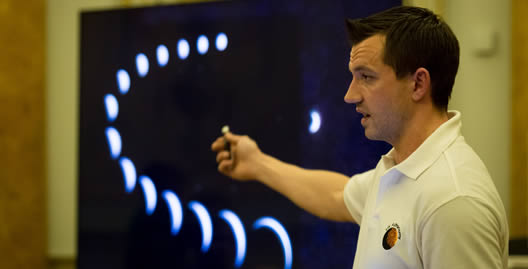








This guide has been put together through our own experiences in the hobby, plus frequently asked questions from the UK Astronomy Facebook group, hope it helps.
You do not need to spend a lot of money to get involved in astronomy. In fact using just your eyes unaided, there’s a whole host of night time objects in the sky you can enjoy.
Our ancestors did this for thousands of years, mapping things like the changing phases of the Moon and the many stars in the sky that make up the constellations. Most people
don’t realise you can also see planets, star clusters, nebulae like Orion's nebula, comets, shooting stars and even galaxies like Andromeda! Dark skies really help to see the
fainter objects in the sky.
We recommend using apps to help you get started with learning the night sky. A favourite amongst amateur astronomers is one called Stellarium. By learning the constellations and
asterisms, they can help you as sign posts to find other objects in the sky - especially within a catalogue of brighter objects known as the Messier catalogue.
Binoculars! They're a great tool and are often under valued for stargazing. 10 x 50s are recommended. They're lightweight and are relatively low power magnification - meaning you can use them without a tripod. Although we recommend one, you can lean against a wall, lay on the ground or a recliner style chair will help keep it steady. More powerful binoculars, like the Celestron 20 x 80 skywatcher, would need a tripod but give amazing views of the stars. Even our 10 x 50 Optricron allow you to see Jupiter’s moons and Saturn’s rings. So if you have any pair of binoculars, go out and try them.
One of the most common questions asked in the UK Astronomy Facebook group is, which telescope should I buy?
Whilst knowing your budget is important for us to be able to specifically recommend a particular scope, we always say ‘the best telescope is the one that you will use’. There are so
many choices out there. We will explore some of the most common types of telescopes available.
We would like to highlight three main types of telescope. They are a lens based (refractor), a mirror telescope (reflector) and a hybrid - both mirror and lenses (catadioptric).
Reflectors are generally cheaper and have bigger apertures so allow more light in for your money. These types of scope are good for deep space objects like galaxies and nebulae.
Refractors have lenses. So they give clearer images but cost a bit more. They have smaller apertures so they let less light in. These types of scope are great for seeing planets and are great
for astrophotography.
Dobsonian mounted telescopes are what we here at UK Astronomy recommend. They are generally cheaper with a wooden base, easy to set up, and you get slightly more bang for your buck.
They are kinda the all-rounder scopes. You can take pics using your phone and with a T-adapter can fit a DSLR camera onto it. But ideally, you’d want a tracking scope later on for
this. The mirrors may need adjusting occasionally, but it’s easy to do using a collimator. There is a huge range of Dobsonian reflectors. The smaller ones you can pop on a bench
or car bonnet and enjoy the skies from £50, to larger ones up to £500 for a 6” to 10” aperture mirror. However, they can be bulky so make sure you check out the weight and size.
Refractors we would recommend for beginners are the Altair Astro 70ed, which is a bit more expensive but great for brighter objects, planets and moon. The Celestron Inspire range is
cheaper, has a red light and the dust cap that also acts as a phone holder - great for kids.
As a beginner, try to avoid equatorial mounted scopes as these slew with the skies, have dials, latitude and are generally tougher to get to grips with. Electronic ‘goto’ tracking scopes, like
the Nexstar 6SE or 8SE range are Catadioptric types of scope - which are great, but you will need power. So think about possibly a power pack or car charging lead if wanting to venture out. The great thing is
they will find and track objects automatically once aligned with a few bright stars. Catadioptric scopes pretty much shorten the overall length of the scope by bouncing the light off mirrors into a lens.
This makes them more portable, but they can be more expensive. Before you buy, why not pop along to a local event, society or group and try some out or chat to others. You can find a list of events being held
near you at www.gostargazing.co.uk.
Now onto the bits and bobs we have been asked in the UK Astronomy Facebook group.
Finder scopes are the little ones on the top of your main scope they have a bigger field of view than the main scope so help you find the object your looking for in your main scope, don’t forget to align it. Find the object in your crosshairs or red dot pop a 25mm eyepiece or biggest numbered one you have in the main scope move till its centred in main scope. Then go back to the finder scope and adjust the knobs, wheels or use Allen key to move the crosshairs or dot until it to is centre on the object. Again check it’s still centred in the main scope so now whatever your finder looks at it should now be in your main scope.
Sometimes there is a misunderstanding on the primary function of telescopes, the telescope itself is all about how much light it can take it. This is linked to the aperture / diameter
of the mirror or lens, this is why when we describe telescopes, we usually mention the aperture, 6 or 8 inch for example. However, it’s the combination of the eyepiece and the focal
length of the telescope which gives us the magnification.
Telescopes usually come with 25mm and 10mm eyepieces, the larger the number the less the magnification, however, you will have a bigger field of view which will help with finding objects,
the higher the magnification the smaller the field of view, therefore it’s not always the case that the highest magnification is the best for whatever object you’re looking at, for example,
with the andromeda galaxy, that takes up quite a good part of the sky.
There are a couple of ‘zoom’ eyepieces that you ‘twist’ to change the focal length. These are OK, but we have found they aren’t as sharp as the fixed focal length eyepieces.
Barlow lenses help multiply your eyepiece by 2 or 3 times thereby giving you a stronger magnification. We find you’re better off just getting a range of cheap eyepieces say 25mm, 20mm, 15mm, 10mm or one that can zoom with a twist. Barlows are great when used with ccd cameras for astrophotography.
There are many different types of filters, Moon filters help dim the brightness of our Moon and also can be used on other objects like ISS and Venus to bring out more detail. UHC and OII filters help bring out details on planets as well as nebulae but do dim them from what we have seen. Coloured filters can bring more out of the Planets.
Turn left at Orion, the Phillips 101 Objects in the Sky has an ISPY like tick sheet for each object which - is great for finding things with the kids. DK also have a range of books that give you loads of info about the universe you’re looking at. Magazine wise the Sky at Night is probably the best. Astronomy Now is a more in depth look and All About Space is great for the kids.
Were lucky to live in a world full of apps for all kinds of things, the ones we use the most are:
Weather Apps : Sat24 | Clear Outside | Scope Nights
Sky Apps : Stellarium | SkySafari | Solar Walk - Planets Explorer
Moon Apps : Moon Globe HD | The Moon: Calendar Moon Phases
Astrophotography Apps : NightCap Camera
(The links above will take you to the respective app in the Apple App Store. The Android version - or alternative - may be available on Google Play, Amazon or the software developer's website.)
NightCap Camera
NightCap Camera is an app that you can use on your phone or iPad to take pics of the skies, you can change focus and iso settings etc and has some great features such as ISS mode, Star trail
mode, meteor mode so well worth a play.
The Altair Astro phone holder is the best and easiest we have tried, but it’s around £50 - £60. If you use your headphones [+] and [-] buttons to take the pics, it will stop the wobble, making the pictures clearer. You can try making your own using an old phone cover. Make a hole in and eyepiece lid and glue it to the phone holder... Voila!
You can get a T-ring adapter for most cameras to enable you to attach your camera directly onto your scope be aware that there may be focussing issues so be sure to check that your telescope is suitable. A tracking mount like a Star Adventurer or the iOptron will enable you to take longer exposure photographs (longer than 30 seconds) CCD cameras are used a lot for astrophotography with a refractor and motorised equatorial mount.
Telescope mirrors have a special coating that generally won’t need cleaning and it takes a lot of dust to make your viewing worse. Baader optical wonder fluid sprayed on a camera or glasses cloth wiped gently on the mirrors works well.
Astrophotography can be quite an advanced subject with many different instruments and tools available. Our charity, UK Astronomy, is more about visual observing, so we won’t delve into
it too much. But whether you're just using your smartphone, CCD or DSLR camera, it can be amazing fun and you’d be blown away at what you can get.
Our resident Astrophotographer, Wil Cheung, has written a beginner’s guide to astrophotography.
We hope this all helps as a rough guide for you.


